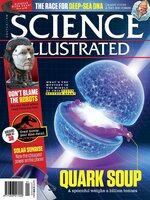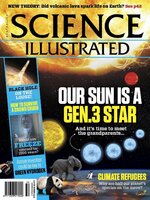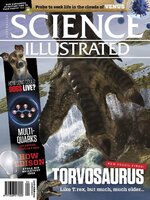Science Illustrated delivers natural science, break through discoveries and an understanding of the world for the entire family. Packed with stunning photography and in-depth editorial it’s a visually spectacular gateway to the world looking into the beginning of life to distant objects in the universe.
Subscribe to SCIENCE ILLUSTRATED for your chance to WIN!
Science Illustrated
Unreal nature: artificial intelligence blurs boundaries
Salt paints: Ukraine’s natural beauty revealed
Space telescope looks inside a huge star factory • The James Webb Space Telescope is proving its power, giving us unprecedented access to previously unknown details of the Orion Nebula. And the view is amazing.
Mirrors capture the universe’s invisible light • Once the James Webb telescope unfolded and reached its final position, its mission began in earnest. The primary mirror captures infrared light (heat radiation) from remote heavenly bodies, and this is passed on to the telescope’s instruments via the secondary mirror.
Drought can be seen from space • Satellite images reveal how the heat of summer quickly changed vast regions of the european continent.
Lean to the right when taking pills • Scientists discover that there can be a huge difference in the time taken to absorb medication depending on which way we lean when we swallow pills.
Warm water and warm air break down the ice cap • Warm ocean water enters between the floating ice shelf in front of the Thwaites Glacier and the solid ice cap.
Evidence mounts beneath the ‘Doomsday glacier’ • The huge Thwaites Glacier in West Antarctica could be even closer to a rapid collapse than previously feared, warns a new study in which scientists sent a robot 700 metres below the freezing cold Antarctic ocean surface.
Cockroaches evolve to outsmart insecticides • Observed changes in the mating procedures of cockroaches led scientists to identify changes that have increased their speed of mating and reduced their desire for sugar.
Preventable factors in too many cancer cases • Too many cancer cases are due to preventable factors. A new study highlights the things you should avoid if you want to reduce your risk.
A plastic-eating ‘superworm’ might help the waste crisis • The larvae of a beetle commonly used as pet food have been found able to consume polystyrene. Australian scientists now hope that the larva – or the enzyme it excretes – might be used on an industrial scale to break down plastics into something useful.
Scientists suggest keeping some poo for a rainy day • Your own faeces might help you avoid severe diseases later in life.
Physicists provide the environment for a continuous atom laser • Until now, atom lasers have only been able to pulse, like the earliest light lasers. Now scientists have found a way to stabilise the environment required to allow continuous operation of such a laser.
SCIENCE UPDATE
“Could I turn myself into a fossil?” • It’s one of the strangest questions we’ve ever received from a reader: could they be preserved for posterity, embedded in rock like a dinosaur bone?
3 ways to fossilise • Under optimum conditions, human bones can be converted into rock.
Why are we afraid of the dark? • Many children are afraid of the dark, and some adults too. Is there an evolutionary reason for us to develop such a widespread fear?
How can I detangle matted hair? • “Last year, my daughter dressed as a witch for Halloween – and had made a mess of her hair for the occasion. It took hours to detangle it. Is there a recommended method?”
Robotic hairdresser combs matted hair • The Robowig robot includes a camera and sensors that measure the force of hair brushing.
“My Mum says ‘Don’t pick your nose!’ What does science...

 Issue 111
Issue 111
 Issue 110
Issue 110
 Issue 109
Issue 109
 Issue 108
Issue 108
 Issue 107
Issue 107
 Issue 106
Issue 106
 Issue 105
Issue 105
 Issue 104
Issue 104
 Issue 103
Issue 103
 Issue 102
Issue 102
 Issue 101
Issue 101
 Issue 100
Issue 100
 Issue 99
Issue 99
 Issue 98
Issue 98
 Issue 97
Issue 97
 Issue 96
Issue 96
 Issue 95
Issue 95
 Issue 94
Issue 94
 Issue 93
Issue 93
 Issue 92
Issue 92
 Issue 91
Issue 91
 Issue 90
Issue 90
 Issue 89
Issue 89
 Issue 88
Issue 88
